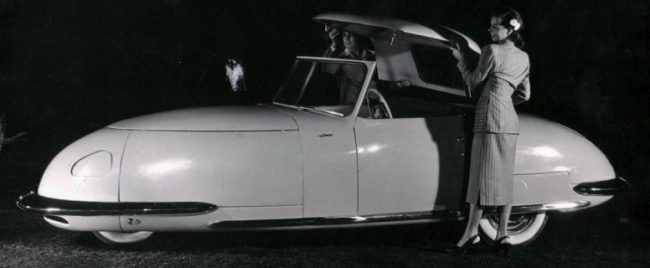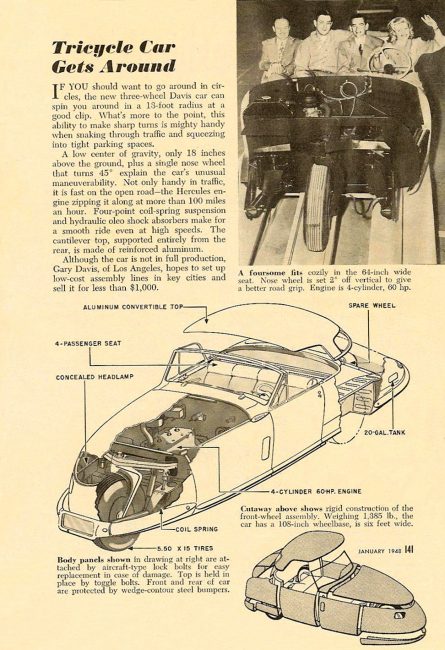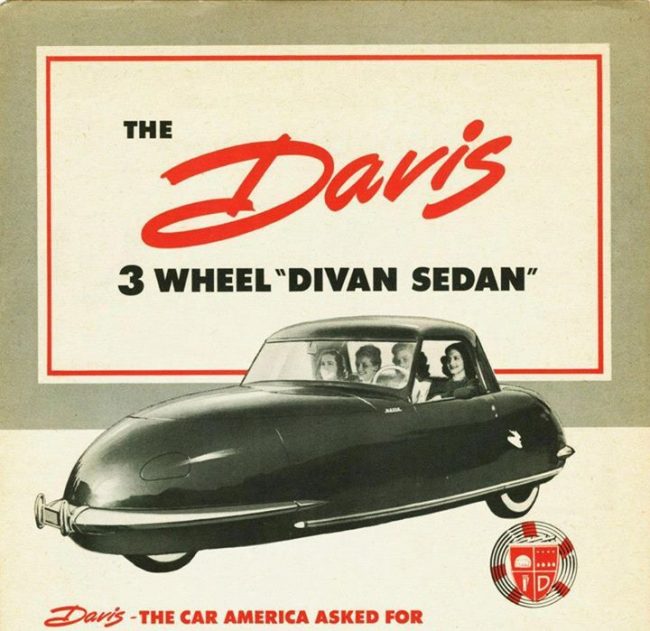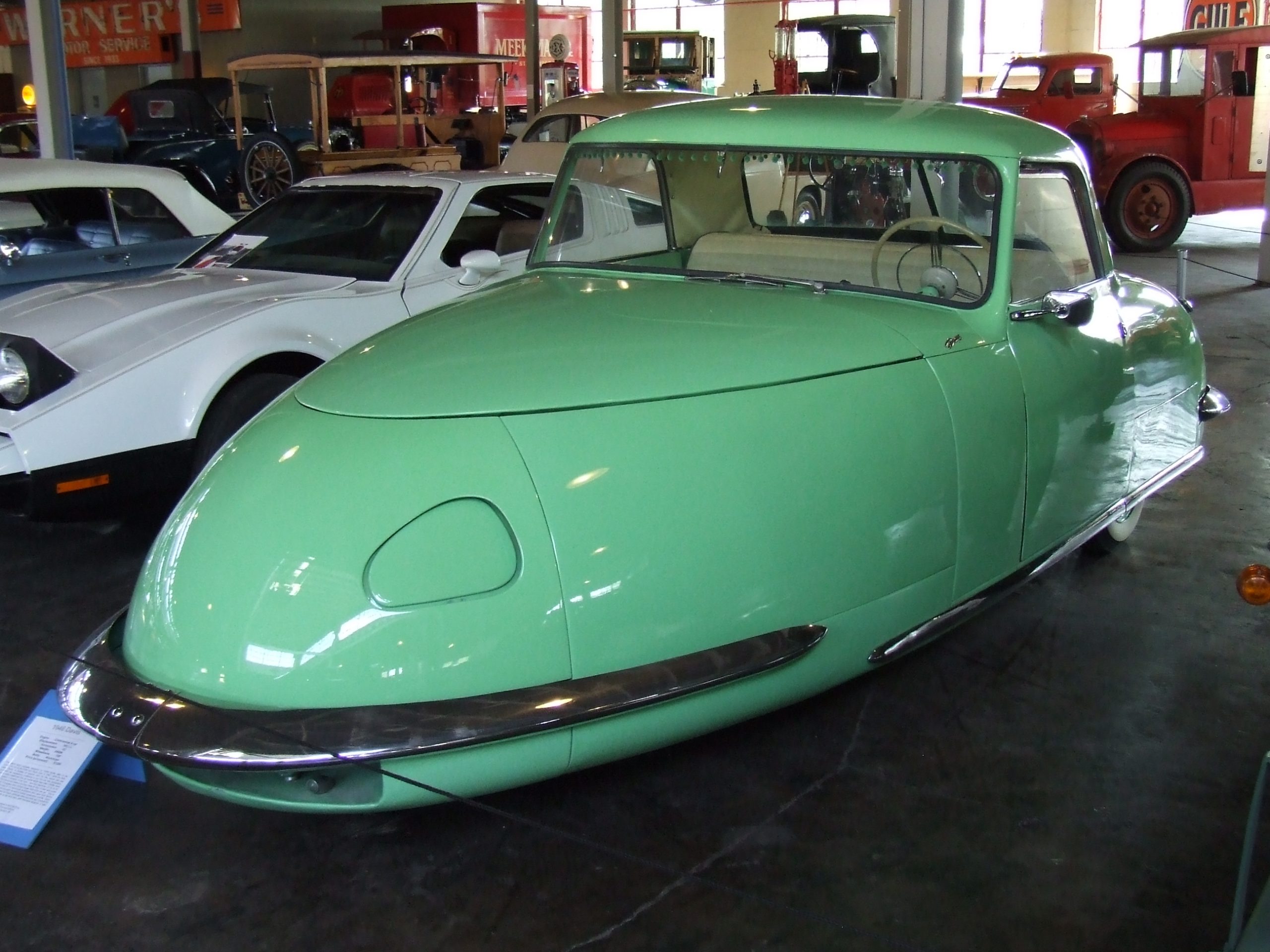Detroit. Kenosha. South Bend. Van Nuys? Maybe the latter doesn’t seem like a car-making town, but it was. For a brief two years, Van Nuys, CA, was home to the Davis, a three-wheeled automobile-cum-sofa.

The Davis story starts with a man named Frank Kurtis, an erstwhile racing car designer and builder of “The Californian”, a three-wheeled roadster commissioned by Southern California racer and banking heir Joel Thorne. It was this car that inspired former Indiana used-car salesman Glen Gordon Davis to create a namesake convertible that would incorporate many features of The Californian.
After moving to Southern California in 1945, Davis purchased the car from Thorne, paying just $50 for it. After purchasing The Californian, Davis hired a group of engineers to reverse-engineer it. Eventually they built a quarter-scale model of the car, which they then photographed for a July 1947 Hollywood News Citizen story, in which they claimed to be able to produce 50 of the cars a day. Later that year, Davis formally created Davis Motorcar Company with a $2,500 investment from the Bendix family; ever conscious of his name and his project’s image, he had borrowed local designer Raymond Loewy’s office to make his successful pitch to Bendix for support.
A former aircraft factory was acquired to house an assembly line, and Davis began cranking out prototypes. The first two-door prototype (“Baby”) had one 15-inch wheel up front and two 15-inch driven wheels out back. Power (such that it was) came from a 47 hp Hercules L-head four-cylinder engine (production cars used a 63 hp, 2.7-liter Continental four) mated to a Borg-Warner three-speed manual. A removable fiberglass hardtop completed the (projected) $995 package.

To capitalize on the booming post-World War II American car market, Davis obtained significant coverage for his new car in prominent magazines such as Business Week, Life, and Parade as well as in a period newsreel and a syndicated television crime drama, The Cases of Eddie Drake.

A public introduction was held at the Ambassador Hotel in Los Angeles in November 1947; During the event, Davis had four American Airlines stewardesses hired for the occasion sit side-by-side across the car’s single bench seat to demonstrate its ability to carry four adults. For additional promotion, “Baby” was repainted and displayed in a Philadelphia department store for the holiday shopping season, after which it was repainted once more in preparation for participating in Pasadena’s Rose Parade before the 1948 Rose Bowl.1

Thanks to a massive publicity effort, which included a nationwide promotional tour featuring The Californian, Davis was able to raise in excess of $1,200,000 from 350 prospective Davis dealers, which allowed the company to finance a nationwide promotional trip, during which Davis touted the Divan as “the ultimate car of the future”.

The production Davis Divan measured 183.5 inches in length with a wheelbase of 109.5 inches–unusually long for a three-wheeled vehicle. Height was five feet even, and weight was 2,450 pounds without the removable hardtop in place. Width was 72 inches, wide enough for a single bench seat that sat four passengers abreast. The steam iron-shaped body featured 11 body panels made of aluminum and zinc; also on board were 15-inch wheels, disc brakes, and hidden headlights. The finished car boasted jacks built into each of its corners, which allowed for easier tire changes.
Davis Divans were soon in the news, and were often featured in periodicals and newspapers. More franchise agreements were signed, yet Davis had oversold and under-financed his futuristic aluminum-bodied car. Worried investors soon began demanding a return on their investments, and began arriving at the company’s factory unannounced to press the engineers for accurate delivery dates. In early 1949, prospective dealers sued Davis for breach of contract; company employees did likewise later that year, since many of them had not been paid after accepting an offer from Davis that promised them double pay after production began if they worked for free during the pre-production phase.

Article from Popular Science, Jan. 1948.
After a Los Angeles County District Attorney investigation, Davis was convicted on 20 counts of fraud and eight counts of grand theft by a jury in 1951. While the Davis Motorcar Company’s assets were liquidated in order to pay back taxes, Davis himself claimed that he could not repay his debts and was instead sentenced to two years at a “work farm” labor camp in Castaic, California 2.

Oddly, Davis’s legacy would not be as the father of the Divan, but rather as the creator of the Dodge-’em bumper car, which bore a strong family resemblance to the Divan and became a popular attraction at amusement parks. Davis died, of emphysema, in 1973.

Of the 13 Divans actually produced, 12 are still known to exist, including one in the permanent collection of the Petersen Museum in Los Angeles.

1, 2 Source: Wikipedia

















14 Comments
Van Nuys does have some more auto manufacturing legacy, it was home the GM Van Nuys plant from 1947 to 1992.
Come gather round people, wherever you roam – Davis goes to jail because a California DA responds to investor concerns about a lack of a return after 2 years on their investment in a futuristic California automaker. Fast forward a few decades, and futuristic California automaker Tesla stock hits $500 per share despite 15 years of never having made an annual profit or ever hitting Musk’s production deadlines, and rather than prosecuting on behalf of disgruntled investors, California is subsidizing the company. The times they are a changin.
That’s the difference between capitalism and fascism in a nutshell. The question people should be asking is why evil people want EVs to look like a viable business.
Think if Davis’s stock was even at $5 he wouldn’t have had to worry about jail. Mr. Musk at least pays his employees and has factories and engineering happening here.
Sitting four narrow hip stewardesses was a stunt but a nice wide bench on a 72 inch wide car could pass today for a nice innovation. Last compact with a bench seat was the 90s Skylark and the self styled brain trust at the car magazines sneered because cars all must be one way.
That and not many people actually choosing that option, or those Skylarks in general. Not hot sellers.
The bench seat continued to be available on pretty much every other Buick through the 2000’s.
To his credit, Musk has built a few more Teslas than the 17 or so Davis Divans that got assembled.
Concerning the Petersen car. From Hemmings in 2015. I can’t remember what I had for dinner last Saturday, but I remember useless stuff like this.
The campaign has numerous levels of support. Spending $5 gets one an ebook of the Davis Divan’s restoration; $10 gets an “I built this car” sticker; $25 gets an “I built this car” shirt; $35 gets an “I built this car” combo pack, with sticker, shirt and ebook; $75 gets a tour of the car under restoration in the greater Los Angeles area (excluding travel); $150 gets a combo pack plus donor’s name on a plaque; $300 gets an invite to the unveiling party at the Petersen (excluding travel), plus a private tour with Leslie Kendall; $1,000 gets an invite to the reveal (excluding travel) plus a drive in the car and all perks below this level.
People at the time thought it was tacky. I concur. Right up Petersen’s alley. Next month they will be showing Metallica’s lead singer James Hetfield’s 1963 Lincoln Continental “Dead Kennedy”.
I’m surprised there’s no 97 MB S-Class called “Snuffed Candle in the Wind”.
I would do the 97 MB tour, even with the boredom of Diana. Too bad there is no way to pay a little more and have Bruno Sacco lead it. He could perhaps explain how Mercedes benefited from making hotel taxi versions with 2.6 engines. Underpowered taxis filling out the factory production schedule is a great German tradition he would probably say.
Then and now: Davis goes to jail, Elon Musk gets government cash.
I believe Leno drove one of these and some issue led to a breakdown that interrupted the ride.
It certainly appears that Davis, while not necessarily dishonest, had an overemphasis on hype as opposed to getting the thing made. I’m inclined to give him more benefit of the doubt than the modern Paul Elio, who combined terrible business decisions with eternal lollygagging on customer’s deposits.
Leno did drive one of these for his show. It’s on his website. I rather enjoy the episode and will watch it from time to time. It did break down on the drive, but the car is a museum piece, not a daily driver.
I would agree with you that the people in the immediate post-war era who were trying to bootstrap new car companies got screwed big time. Tucker is another name that comes to mind, along with Davis.
The Divan appeals to me on a level that I really can’t quite describe; there’s something so whimsical and silly about it. I can’t imagine anyone releasing a new car today that’s “friendly looking”, maybe the first gen Neon was the last one. I guess we’re well and truly into the “angry appliance” era, and I really don’t think bloated CUVs will be our deliverance, either.
I went back and watched Leno and the Divan. They stalled out because the car had some aftermarket fuel cap that was not vented. They eventually figured that out and were back on their way.
I guess the Corbin Sparrow was about two decades ago. We do have the current problem of “angry looking cars.”
That’s exactly why the AMC Pacer still appeals to me.
Myron Vernis has a Davis Divan. He told me that it’s “terrifying” to drive and that he won’t take it about 45 mph.
When I interviewed Jay Leno he invited me to his shop. As it happened, when I was able to get to his garage when I was in LA he was busy shooting with one of the Batmobiles and a Davis Divan that day. After I got a tour of the facility, I hung around nearby and got some video of the Davis breaking down while Leno was driving it. It’s not the same blue Davis as the Petersen car, though, and I can’t find a Jay Leno’s Garage episode with the green car that I saw him drive so maybe they never finished that episode.